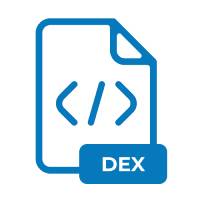.DEX File Extension

Dalvik Executable File
| Developer | |
| Popularity | |
| Category | Developer Files |
| Format | .DEX |
| Cross Platform | Update Soon |
What is an DEX file?
.DEX file stands out as a crucial component in the realm of Android application development. Short for Dalvik Executable, this file format plays a pivotal role in the execution of code within the Android operating system.
Understanding its origins, structure, and functionalities provides invaluable insight into the inner workings of Android applications.
More Information.
Before the advent of Dalvik, Java applications for Android were compiled into bytecode, which was then executed by the Java Virtual Machine (JVM).
The resource-intensive nature of JVM made it unsuitable for mobile devices with limited processing power and memory. Dalvik emerged as a lightweight alternative, featuring a register-based architecture tailored for mobile environments.
The primary purpose of .DEX files are to store the compiled bytecode of Android applications. During the build process, Java source code is compiled into .class files using the Java compiler (javac).
These .class files are then transformed into Dalvik bytecode and packaged into .APK (Android Package) files along with other resources such as images, layouts, and configuration files.
Origin Of This File.
The .DEX file format owes its existence to the Dalvik Virtual Machine (DVM), the runtime environment employed by Android.
Named after a fishing village in Iceland, Dalvik was developed by Dan Bornstein and initially released alongside the Android software stack in 2008.
It was designed specifically to address the resource constraints of mobile devices while ensuring optimal performance for executing bytecode.
File Structure Technical Specification.
The structure of .DEX files adhere to a specific format optimized for efficient execution within the Dalvik Virtual Machine.
At its core, a .DEX file consists of a header section followed by multiple variable-length sections containing different types of data.
The header section provides essential information about the file, including its size, endian tag, magic number, and checksum.
Following the header, the file contains the bytecode instructions, method definitions, constant pools, class definitions, and other necessary metadata.
The bytecode instructions within .DEX files are encoded in a compact format optimized for reduced memory overhead and faster execution.
Each instruction is represented by a single byte or a combination of bytes, enabling efficient storage and interpretation by the Dalvik runtime.
How to Convert the File?
Converting .DEX files to other formats or vice versa typically involve decompilation and recompilation processes.
Several tools and frameworks are available for decompiling .DEX files back into Java source code, enabling developers to analyze or modify existing applications.
One popular tool for decompiling .DEX files are jadx, an open-source Java decompiler that supports Android APKs. By running jadx on an APK containing .DEX files, developers can obtain human-readable Java source code, facilitating reverse engineering and debugging tasks.
Conversely, converting Java source code into .DEX files involve compilation using the Android SDK tools, such as dx (Dalvik eXchange).
During the build process, the Java bytecode generated by the Java compiler is transformed into .DEX format and packaged into the final APK.
Advantages And Disadvantages.
One of the key advantages of .DEX files and the Dalvik Virtual Machine are suitable for resource-constrained environments.
By employing a register-based architecture and compact bytecode format, Dalvik achieves superior performance and memory efficiency compared to traditional JVM-based approaches.
Additionally, the separation of bytecode from the original Java class files enhances security and obfuscation, making it more challenging for reverse engineers to analyze and modify Android applications.
However, the transition from Dalvik to the Android Runtime (ART) starting with Android 5.0 Lollipop introduced a new file format (.OAT) and runtime environment with further optimizations.
While ART retains compatibility with .DEX files through a process called Ahead-of-Time (AOT) compilation, the focus has shifted towards improving runtime performance and reducing startup times.
How to Open DEX?
Open In Windows
- Using JADX: JADX is a powerful decompiler for Android applications that allows you to open .DEX files and view their contents as Java source code. You can download JADX from its GitHub repository and follow the instructions for installation and usage.
- Using APKTool: APKTool is another utility for reverse engineering Android applications, which can decode .APK files (containing .DEX files) and extract their contents for inspection and modification. You can download APKTool from its official website and use it to open .DEX files.
Open In Linux
- Using JADX or APKTool: The process for opening .DEX files on Linux is similar to that on Windows. You can use JADX or APKTool, both of which are compatible with Linux distributions. Install them using the appropriate package manager or download them from their respective sources.
Open In MAC
- Using JADX or APKTool: Similarly, you can use JADX or APKTool on macOS to open .DEX files. These tools are platform-independent and can be installed and used on macOS just like on Linux and Windows.
Open In Android
- Using jadx-gui: JADX provides a GUI version called jadx-gui, which you can install directly on your Android device. You can download jadx-gui from the Google Play Store or third-party app stores and use it to decompile .DEX files directly on your Android device.
Open In IOS
- Using Online Services: Due to the closed nature of iOS, it’s challenging to directly open .DEX files on iOS devices. However, you can use online services or cloud-based decompilers to upload .DEX files and view their contents as Java source code through a web browser on your iOS device.
Open in Others
- Using Docker Containers: You can set up Docker containers running Linux distributions on other operating systems (such as Windows or macOS) and use JADX or APKTool within the Docker environment to open .DEX files.
- Using Virtual Machines: Similarly, you can run virtual machines with Linux distributions on other operating systems and use JADX or APKTool within the virtual environment to open .DEX files.













